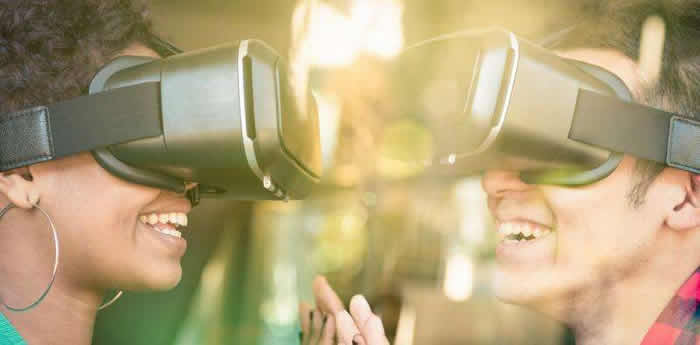Today’s generation is so connected, but not necessarily in a good way. The vast majority of us are constantly connected to the things we like and those we are close to through technology – to the point where we may even have problems managing without it.
When something like virtual reality (VR) came along, for many people it was a game changer, the best thing since sliced bread. It can quickly become part of our already tech-reliant lives, providing us with multiple new possibilities, including for falling in love.
VR is now more immersive and believable than ever before. Cheaper hardware and faster software means it is within our reach at home. VR has become a walk-in painting, a gut-wrenching white-knuckle ride, and a mystical land where you can defy gravity.
Likewise, you can visit real world places using VR, witness events or learn something new. Putting on a headset and using motion trackers can transport you into a different universe. It doesn’t need to be expensive or highly specialized – you can jump in from the comfort of your living room with commercially available technology.
VR has a wonderful history of geeked-out subcultural tech communities, experimenting with what it means to be tech-social. Already there are dating apps, 360° virtual experiences and online multi-player gaming. But it is going beyond this, and allowing humans to have much deeper interactions with one another.
Physical barriers
Touch is such an important part of building relationships that it can be difficult to see how this can be overcome in the virtual world. After all, without a physical presence, you cannot feel the other person, or react to small movements and expressions that we are all innately attuned to.
There has already been a great deal of interest in the sensationalism that VR can offer.
VR sex, as VR sensual experience or standard pornography, tends to focus on bodily arousal, infidelity and kink. However, it isn’t always like this, it can be more romantic than that: ‘The Kissenger’ allows you to ‘kiss’ someone using a mobile phone add-on, for example, making the virtual a little more real. And immersive sensual suits with haptic feedback can make that special date on a VR dance floor even more memorable.
Online connections have allowed us to communicate over vast distances, meet others we like and share interests with, and even build relationships for many years now.
As humans we are not limited to interacting with those physically near us anymore, but virtual reality is taking us one step beyond chatrooms and the like. Interacting with another avatar’s physical appearance – one which displays a style that the person may be unable to portray in real life – adds an extra level to things.
We can talk and interact with them almost as if they are physically in the same room, even though they may be on the opposite side of the world.
The digitized self in virtual space is complex, however. Though it enables you to be emotionally immersed within the technology and for you to have a digital presence in the VR world that others can see and interact with, your body remains outside. This could cause potential problems – should a couple later meet in the real world and find no attraction to each other – but it also removes a barrier between two potential lovers. Humans are so focused on looks that it can stop a perfect match ever meeting.
When you have lost your sense of disbelief in the virtual world, and question where the self begins and the physical body ends, romantic love in a virtual space can start to feel very real. VR love brings two minds together with phantom bodies, but in a positive way it can make us question what it means to be human – and how we understand our sense of self in connection to others. It allows us to explore who we are and reveal how we love without the looks or traits that we feel define us physically.
Digital love
It is very easy for VR relationships to blossom within the digital space, as users experience fantasies and challenges together. These exhilarating shared experiences can bring a relationship into focus. The adventures become joint intimate stories and memories – and the two individuals begin exploring themselves as a couple as well as traveling the VR world. For those in love, the times that you are not in the VR world can become fraught with longing for the other person – and the reality you have created.
The ability to experience such connection and emotion can be far more immersive in VR, as time is dedicated specifically to ‘playing out’ the relationship. It can even be used as a place for couples to experiment with living together while still physically being far apart.
The long-term results and impacts of love and relationships in virtual reality are yet to be seen and felt, but the fact is that they are happening. Yes, there still may be those instances where a couple cannot overcome physical attributes when meeting in the real world after joining together in VR, as happens with other online relationships.
But as the boundaries between the physical and digital worlds become more blurred, humans might become less concerned with what happens in reality and rely on the strength of their virtually built emotional attachment.
More information: TechXplore



